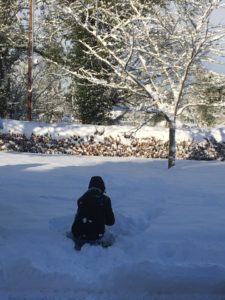
We all know the proprioceptive activities help to restore calm and order to the body. Proprioception is the information that is sent from muscles and joints in our body to our brain. It gives the brain information about our position in space and where we are in relation to others. This in turn gives reassurance and helps our brain to regulate sensory input. How do we get this magical input? Through muscle work!
Playing in the snow is a great way to provide proprioception for our kids. Walking in deep snow is muscle work all by itself. We need to change our patterns of movement and engage all our muscles to maintain our balance. We also have to contend with the resistance of the snow when walking or making snow angels.
Snowball fights add to this proprioception by increasing the work as we need to run through the snow. We are also engaging more muscles when we duck and bend as these are not typical movement patterns for us. Using our hands to push and compact snowballs and then muscles in our arms when throwing further increases the impact of this activity. It’s important to note that this is only a good activity if your child enjoys snowball fights and will not get distress if they are hit with a snowball.
Another great activity is building snow people, animals and igloos. All of the bending, lifting and dragging is great to give proprioceptive input but these activities also encourage team working and planning skills. There is also such a great sense of achievement when the product is complete. Start with something small and easy and as your child gets a sense of mastery with this they will want to continue to build more.
After some time playing outside, everyone loves a hot drink and some snacks. For some added sensory input give your child a straw with their hot chocolate, or even better, let them suck it up through a timeout, twirl or penguin bar. This is messy but lots of fun and it needs a lot of work which again is calming for the sensory systems. (The Australians were onto something with their tam-tams and tea)
For children who prefer to stay inside and out of the cold, lets get on the bread bandwagon and bake some. This is a great tactile experience for children and it also involve lots of arm muscle work when mixing ingredients and kneading the bread. Again, this activity takes planning and organising as they need to get all the ingredients, weigh out the correct amounts and follow the recipe. You can take this as an opportunity to do lots of batch cooking and freezing so your always prepared with fresh bread, scones or cookies. And don’t forget the muscle work involved in cleaning up after.
After long days of playing in snow and baking away your children’s sensory needs should be nicely met and ready or a relaxing evening and a great sleep.
Written by
Amanda Kelly, Senior Occupational Therapist at Sensational Kids
Copyright Sensational Kids CLG 2018

